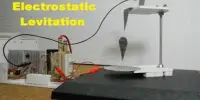An electromagnet is a type of magnet that generates a magnetic field by using an electric current. Electromagnets are typically made of wire wound into a coil. It is a type of magnet that generates a magnetic field by using an electric current. A current flowing through the wire produces a magnetic field that is concentrated in the coil’s center hole. When the current is turned off, the magnetic field vanishes. In contrast to permanent magnets, which have a constant magnetic field, an electromagnet’s magnetic field can be controlled by varying the amount of current flowing through it. The wire turns are frequently wound around a magnetic core made of a ferromagnetic or ferrimagnetic material, such as iron; the magnetic core concentrates the magnetic flux, resulting in a stronger magnet.
An electromagnet’s basic structure is a coil of wire wound around a ferromagnetic core, such as iron. A magnetic field is formed around the coil when an electric current flows through the wire. The magnetic field’s strength is determined by the number of turns in the coil, the amount of current flowing through it, and the properties of the core material.
Advantages
The main advantage of an electromagnet over a permanent magnet is the ability to quickly change the magnetic field by controlling the amount of electric current in the winding. In contrast to a permanent magnet, which requires no power, an electromagnet requires a constant supply of current to maintain the magnetic field.
Applications
Motors, generators, electromechanical solenoids, relays, loudspeakers, hard disks, MRI machines, scientific instruments, and magnetic separation equipment all use electromagnets as components. In industry, electromagnets are used to pick up and move heavy iron objects such as scrap iron and steel.
The magnetic field produced by an electromagnet has several applications in various industries and everyday devices. Here are a few examples:
- Electric motors and generators: Electromagnets are commonly used in electric motors and generators. By applying a current to the electromagnet’s coil, a rotating magnetic field is created, which interacts with other magnets or conductors to produce mechanical motion or electrical energy.
- Magnetic resonance imaging (MRI): MRI machines use powerful electromagnets to generate a strong and uniform magnetic field. This field interacts with the body’s atoms, allowing detailed imaging of internal structures for medical diagnosis.
- Magnetic levitation (maglev) trains: Maglev trains use powerful electromagnets to create a magnetic field that repels the train from the tracks, allowing for frictionless and high-speed transportation.
- Loudspeakers and headphones: The diaphragms in loudspeakers and headphones are connected to electromagnets. As the electrical current varies, the magnetic field produced by the electromagnet interacts with permanent magnets, causing the diaphragm to vibrate and produce sound waves.
















